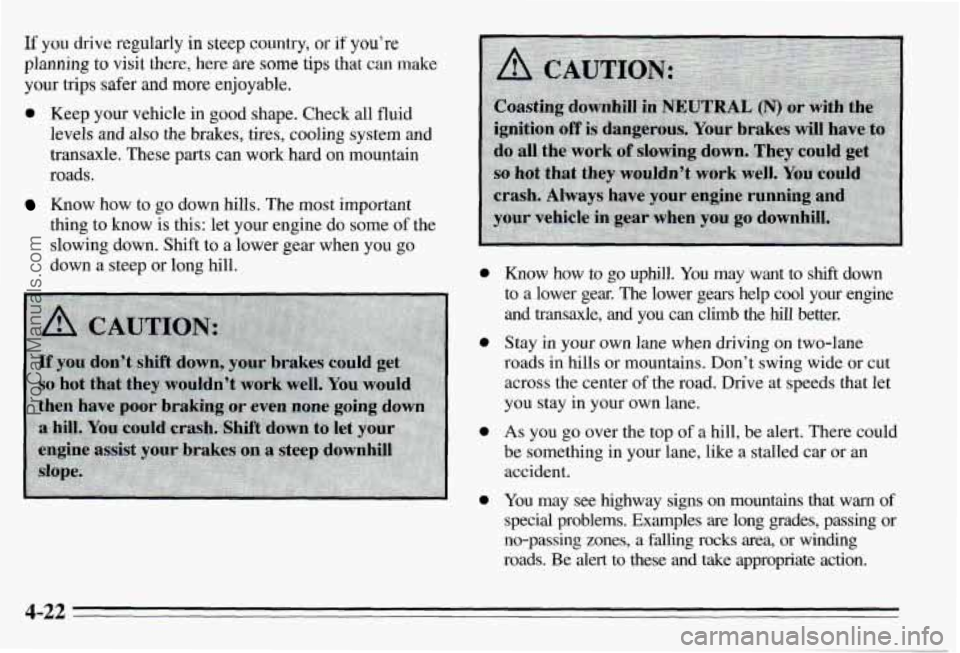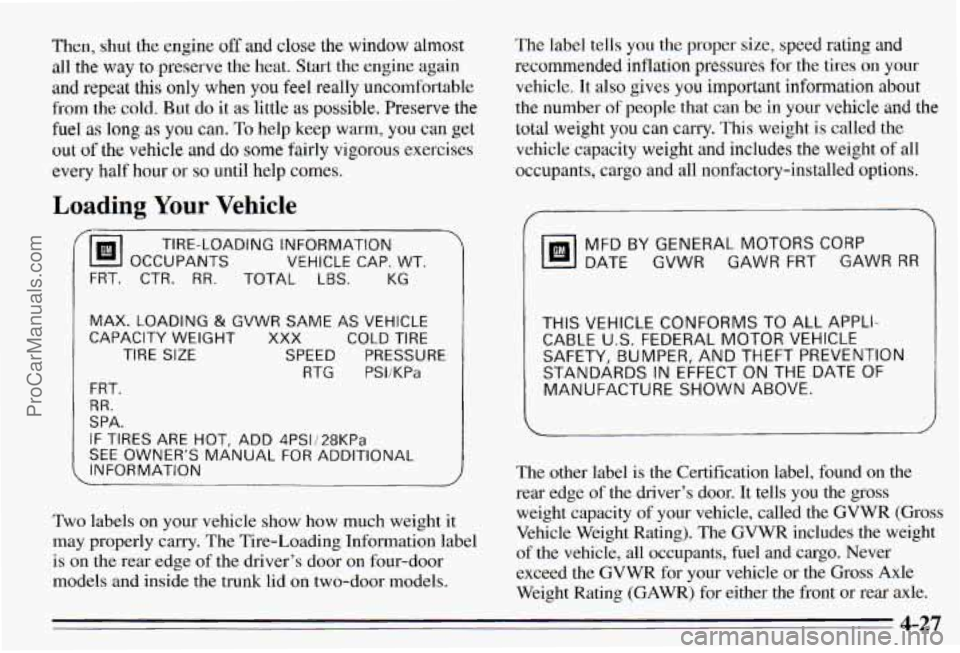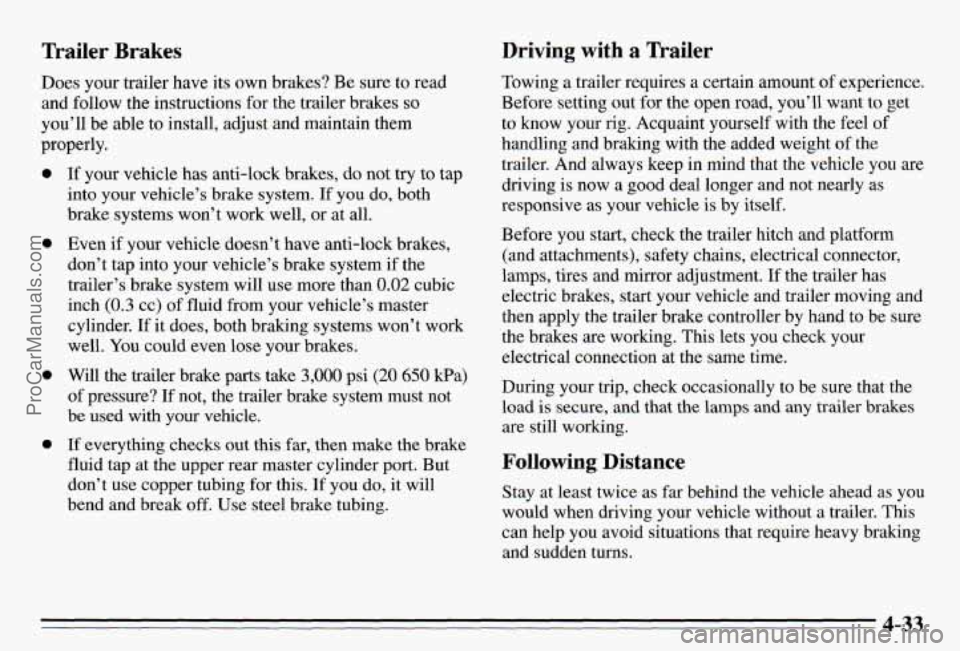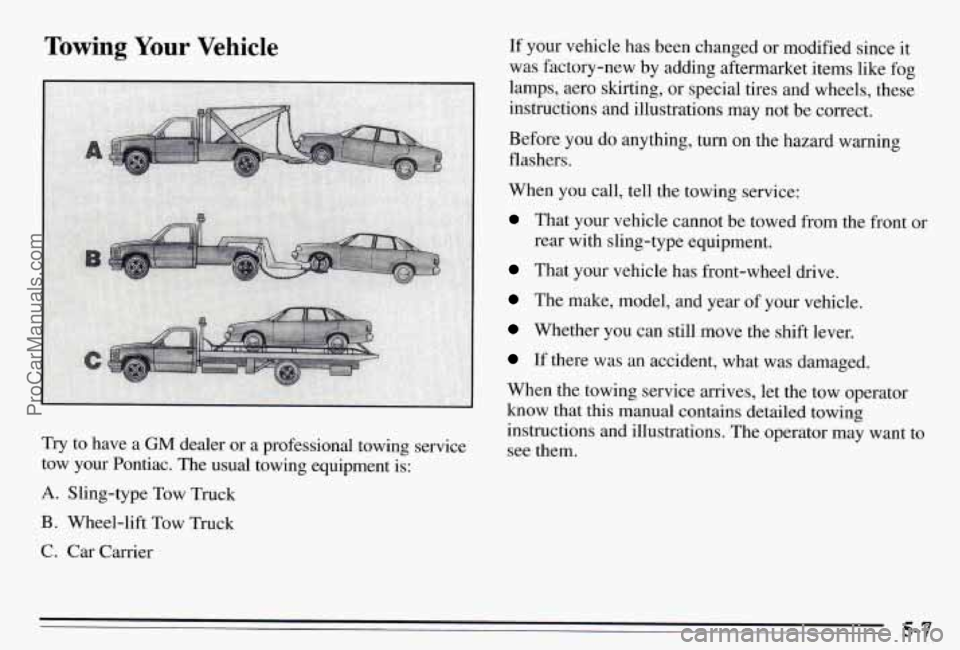1995 PONTIAC PONTIAC tires
[x] Cancel search: tiresPage 164 of 354

Highway Hypnosis
Is there actually such a condition as “highway
hypnosis”?
Or is it just plain falling asleep at the wheel?
Call it highway hypnosis, lack
of awareness, or
whatever.
There
is something about an easy stretch of road with
the same scenery, along with the hum
of the tires on the
road, the drone of the engine, and the rush
of the wind
against the vehicle that can make you sleepy. Don’t let it
happen to you!
If it does, your vehicle can leave the
road in
less than a second, and you could crash and be
injured.
What can you do about highway hypnosis? First, be
aware that
it can happen.
Then here are
some tips:
0
0
0
Make sure your vehicle is well ventilated, with a
comfortably cool interior.
Keep your eyes moving. Scan the road ahead and to
the sides. Check your rearview mirrors and your
instruments frequently.
If you get sleepy, pull off the road into a rest, service,
or parking area and take
a nap, get some exercise, or
both. For safety, treat drowsiness
on the highway as
an emergency.
Hill and Mountain Roads
Driving on steep hills or mountains is different from
driving in flat or rolling terrain.
4-2 1
ProCarManuals.com
Page 165 of 354

If you drive regularly in steep country, or 11 you re
planning to visit there, here are some tips that can make
your trips safer and more enjoyable.
0 Keep your vehicle in good shape. Check all fluid
levels and
also the brakes, tires, cooling system and
transaxle. These parts can work hard on mountain
roads.
Know how to go down hills. The most important
thing to know is this: let your engine do some
of the
slowing down. Shift to a lower gear when you go
down a steep or long hill.
0
0
a
0
Know how to go uphill. You may want to shift down
to a lower gear. The lower gears help cool your engine
and transaxle, and you
can clirnb the hill better.
Stay in
your own lane when driving on two-lane
roads in
hills or mountains. Don’t swing wide or cut
across the center
of the road. Drive at speeds that let
you stay in your own lane.
As you go over the top of a hill, be alert. There coula
be something
in your lane, like a stalled car or an
accident.
You may
see highway signs on mountains that warn of
special problems. Examples are long grades, passing or
no-passing zones, a falling
rocks area, or winding
roads. Be alert to these and take appropriate action.
4-22
ProCarManuals.com
Page 167 of 354

Driving on Snow or Ice
Most o€ the time, those places where your tires meet the
road probably have
good traction.
However, if there
is snow or ice between your tires and
the road, you can have a very slippery situation. You’ll
have a lot less traction or
“grip” and will need to be very
careful.
What’s the worst time for this? “Wet ice,” Very cold
snow or ice can be slick and hard to drive on. But wet
ice can be even more trouble because it may offer the
least traction of all. You can get “wet ice” when it’s
about freezing (32 OF; 0” G) and freezing rain begins to
€all. Try to avoid driving on wet ice until salt and sand
crews can
get there.
Whatever the condition
-- smooth ice, packed, blowing
or loose snow
-- drive with caution. Accelerate gently.
Try not to break the fragile traction. If you accelerate
too fast, the drive wheels will spin and polish the surface
under the tires even more.
Unless you have the anti-lock braking system, you’ll
want to brake very gently, too.
(If you do have anti-lock,
see “Anti-Lock” in the Index. This system improves
your vehicle’s ability to make a hard stop on
a slippery
road.) Whether you have the anti-lock braking system or
not, you’ll want to begin stopping sooner than you
would on dry pavement. Without anti-lock brakes, if
you feel your vehicle begin to slide, let up on the brakes
a little. Push the brake pedal down steadily to get the
most traction you can.
4-24
ProCarManuals.com
Page 170 of 354

Then, shut the engine off and close the window almost
all the
way to preserve the heat, Start the engine again
and repeat this only when
you feel really uncomfortable
from the cold. But do
it as little as possible. Preserve the
he1 as long as you can. To help keep warm, you can get
out
of the vehicle and do sume fairly vigorous exercises
every half hour
or so until help comes.
Loading Your Vehicle
/bI OCCUPANTS
VEHICLE CAP. WT.
TIRE-LOADING INFORMATION
FRT.
CTR. RR. TOTAL LBS. KG
MAX. LOADING & GVWR SAME AS VEHICLE I
CAPACITY WEIGHT XXX COLD TIRE
TIRE
SIZE SPEED PRESSURE
RTG PSI/KPa
FRT.
RR.
SPA.
IF TIRES ARE HOT, ADD 4PS1/28KPa
SEE OWNER’S MANUAL
FOR ADDITIONAL
INFORMATiON
/
Two labels on your vehicle show how much weight it
may properly carry. The Tire-Loading Information label
is on
the rear edge of the driver’s door on four-door
models and inside the trunk lid on two-door models. The label tells you the proper
size, speed rating and
recommended inflation pressures
for the tires on your
vehicle.
It also gives you important information about
the number of people that can be in your vehicle and the
total weight
you can carry. This weight is called the
vehicle capacity weight and includes the weight
of all
occupants, cargo and all nonfactory-installed options.
MFD BY GENERAL MOTORS CORP
DATE GVWR GAWR FRT GAWR RR
THIS VEHICLE CONFORMS TO ALL APPLI-
CABLE
U.S. FEDERAL MOTOR VEHICLE
SAFETY, BUMPER, AND THEFT PREVENTION
STANDARDS IN EFFECT ON
THE DATE OF
MANUFACTURE SHOWN ABOVE.
The other label is the Certification label, found on the
rear edge of the driver’s door. It tells you the
gross
weight capacity of your vehicle, called the GVWR (Gross
Vehicle Weight Rating). The GVWR includes the weight of
the vehicle, all occupants, fuel and cargo. Never
exceed the GVWR for your vehicle or the Gross
Axle
Weight Rating (GAWR) for either the front or rear axle.
4-27
ProCarManuals.com
Page 172 of 354

Towing a Trailer
NOTICE:
Pulling a trailer improperly can damage your
vehicle and result in costly repairs not covered by
your warranty.
To pull a trailer correctly, follow
the advice in this part, and see your Pontiac
dealer for important information about towing
a
trailer with your vehicle.
Your vehicle can tow a trailer. To identify what the
vehicle trailering capacity is for your vehicle, you should read the information in “Weight
of the Trailer”
that appears later in this section. But trailering is
different than just driving your vehicle by itself.
Trailering means changes in handling, durability, and
fuel economy. Successful, safe trailering takes correct
equipment, and
it has to be used properly.
That’s the reason for this part.
In it are many
time-tested, important trailering tips and safety rules.
Many of these are important for your safety and that
of
your passengers. So please read this section carefully
before you pull a trailer.
Load-pulling components such as the engine, transaxle,
wheel assemblies, and tires are forced to work harder
against the drag of the added weight. The engine is
required to operate at relatively higher speeds and under greater loads, generating extra heat. What’s more, the
trailer adds considerably to wind resistance, increasing
the pulling requirements.
4-29 ProCarManuals.com
Page 174 of 354

Weight of the Trailer Tongue
The tongue load (A) of any trailer is an important
weight to measure because it affects the total capacity
weight of your vehicle. The capacity weight includes the
curb weight of the velucle, any cargo you
may carry in
it, and the people who will be riding in the vehicle. And
if you will tow a trailer, you must subtract the tongue
load from your vehicle’s capacity weight because your
vehicle will be carrying that weight, too. See “Loading
Your Vehicle” in the Index for more information about
your vehicle’s maximum load capacity.
A B
If you’re using a “dead-weight” hitch, the trailer
tongue
(A) should weigh 10% of the total loaded
trailer weight
(B). If you have a “weight-distributing”
hitch, the trailer tongue
(A) should weigh 12% of the
total loaded trailer weight
(B).
After you’ve loaded your trailer, weigh the trailer and
then the tongue, separately, to see if the weights
are
proper. If they aren’t, you may be able to get them right \
simply
by moving some items around in the trailer.
Total Weight on Your Vehicle’s Tires
Be sure your vehicle’s tires are inflated to the
recommended pressure for cold tires. You’ll find these
numbers on the Tire-Loading Information label (found
on the rear edge of the driver’s door or on the inside
of
the trunk lid) or see “Loading Your Vehicle” in the
Index. Then be sure you don’t go over the
GVW limit
for your vehicle, including the weight of the trailer
tongue.
4-31
ProCarManuals.com
Page 176 of 354

Trailer Brakes Driving with a Trailer
Towing a trailer requires a certain amount of experience.
Before setting out for the open road, you’ll want to get
to know your
rig. Acquaint yourself with the feel of
handling and braking with the added weight of the
trailer. And always keep in mind that the vehicle you are
driving is now
a good deal longer and not nearly as
responsive as your vehicle is by itself.
Before you start, check the trailer hitch and platform
(and attachments), safety chains, electrical connector,
lamps, tires and mirror adjustment.
If the trailer has
electric brakes, start your vehicle and trailer moving and
then apply the trailer brake controller by hand to be sure
the brakes are working. This lets you check your
electrical connection at the same time.
Does your
trailer have its own brakes? Be sure to read
and follow the instructions for the trailer brakes
so
you’ll be able to install, adjust and maintain them
properly.
0
a
0
0
If your vehicle has anti-lock brakes, do not try to tap
into your vehicle’s brake system.
If you do, both
brake systems won’t work well, or at all.
Even
if your vehicle doesn’t have anti-lock brakes,
don’t tap into your vehicle’s brake system
if the
trailer’s brake system will use more than
0.02 cubic
inch
(0.3 cc) of fluid from your vehicle’s master
cylinder.
If it does, both braking systems won’t work
well.
You could even lose your brakes.
Will the trailer brake parts take 3,000 psi (20 650 Wa)
of pressure? If not, the trailer brake system must not
be used with your vehicle.
If everything checks out this far, then make the brake
fluid tap at the upper rear master cylinder port. But
don’t use copper tubing for this. If you do, it will
bend and break off. Use steel brake tubing. During
your trip, check occasionally to be sure that the
load is secure, and that the lamps and any trailer brakes
are still working.
Following Distance
Stay at least twice as far behind the vehicle ahead as you
would when driving your vehicle without a trailer. This
can help you avoid situations that require heavy braking
and sudden turns.
4-33
ProCarManuals.com
Page 186 of 354

Towing Your Vehicle
Try to have a GM dealer or a professional towing service
tow your Pontiac. The usual towing equipment is:
A. Sling-type Tow Truck
B. Wheel-lift Tow Truck
C. Car Carrier
If your vehicle has been changed or modified since it
was factory-new by adding aftermarket items like
fog
lamps, aero skirting, or special tires and wheels, these
instructions and illustrations may not be correct.
Before you do anything,
turn on the hazard warning
flashers.
When you call, tell the towing service:
That your vehicle cannot be towed from the front or
rear with sling-type equipment.
That your vehicle has front-wheel drive.
The make, model, and year of your vehicle.
Whether you can still move the shift lever.
If there was an accident, what was damaged.
When the towing service arrives, let the tow operator
know that this manual contains detailed towing
instructions and illustrations. The operator may want to
see them.
~- .
5-7 ProCarManuals.com